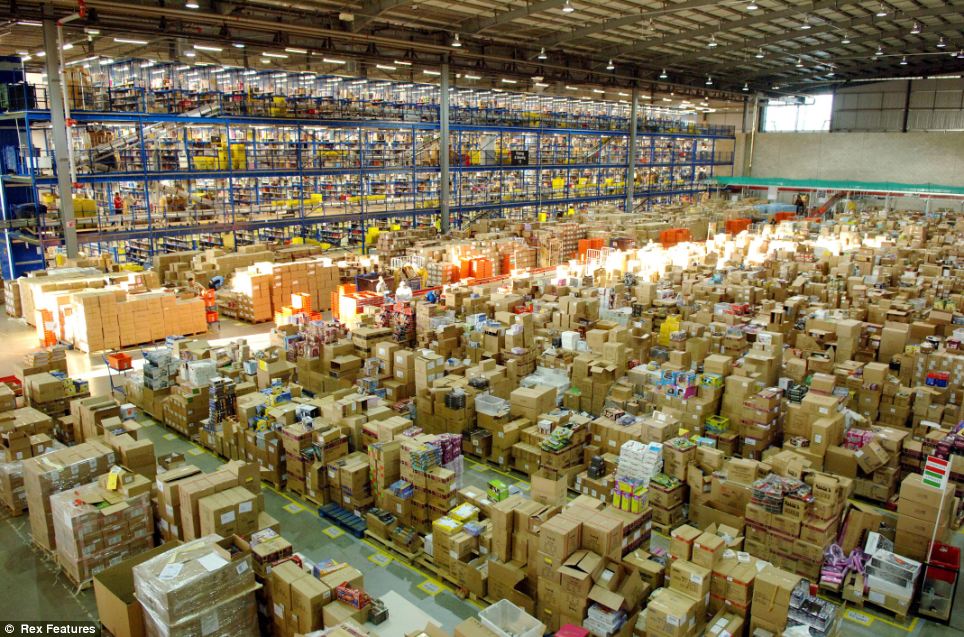
The Amazon Finding System
 Last week, I found myself channel-surfing at my local gym to find the right motivational show to watch while I worked out on the elliptical machine. You may be surprised to hear that I stopped on a news story describing the inner workings of Amazon.com’s fulfillment centers (of which there are currently 80 around the world with the largest, in Phoenix, the size of 28 football fields). While you wouldn’t normally think this type of entertainment would keep someone going as they work through various levels of interval training, something the reporter said kept me listening. He said Amazon doesn’t care where its employees store the thousands of merchandise items that are put away each day. In fact, Amazon expects its workers to store things where they fit best. So if that means a box of golf balls is located next to a can of hair spray, so be it.
Last week, I found myself channel-surfing at my local gym to find the right motivational show to watch while I worked out on the elliptical machine. You may be surprised to hear that I stopped on a news story describing the inner workings of Amazon.com’s fulfillment centers (of which there are currently 80 around the world with the largest, in Phoenix, the size of 28 football fields). While you wouldn’t normally think this type of entertainment would keep someone going as they work through various levels of interval training, something the reporter said kept me listening. He said Amazon doesn’t care where its employees store the thousands of merchandise items that are put away each day. In fact, Amazon expects its workers to store things where they fit best. So if that means a box of golf balls is located next to a can of hair spray, so be it.
So how do Amazon’s Fulfillment Associates quickly find the Floating Bubbles Light-up Pen you just ordered for your child’s Christmas stocking? They use a computer system, scanners, and a set of bar codes, one on the product and one on the shelf, to inventory and index each individual item. Shelves do not need be labeled and re-labeled as products come and go. In other words, even though inventory is constantly changing, the storage system remains static. Think of the time and money Amazon saves with this system.
Now let’s take this down to a smaller scale – your own company’s warehouse or storage area, its central library, your own personal library, or your office files. Amazon’s system of static labeling and electronic indexing can apply to all of these environments. With an inventory model like this, it doesn’t matter where items are stored as long as they are labeled and tagged appropriately in an electronic indexing system. One quick search will point you in the right direction in seconds.
As an example, let’s discuss how to apply this to your paper files. First, label each file with a number (e.g. Reference 1, Reference 2, etc.). Then, use one of the following systems to index these files according to the title and contents.
- A basic Excel Spreadsheet with columns for the file number, category (if applicable), title and keywords or descriptions of contents of the file. In addition, you may customize the Excel workbook further by having separate worksheets for different information types (Action, Reference, Books, Binders, CD’s, etc.). Excel’s search feature allows you to quickly find information by title or keyword.
- Take your indexing system a step further by using a software program built specifically for paper filing and office inventory, such as Taming the Paper Tiger Software.
- An additional option for indexing of paper and other information is iPEP (interactive-Productive Environment Platform). In this cloud-based system, you can not only inventory your physical information but also store your electronic files, email, links, photos and other digital information.
Note: To learn more about each of the systems described or to learn if any of them is right for your needs, please contact Lori at Life Made Simple.
While your indexing system may not tell you exactly which path to walk to retrieve your items in the most efficient way, as Amazon’s does, it will go a long way towards creating an organized and productive environment where you can be comfortable knowing you will find what you need when you need it.

Recent Comments